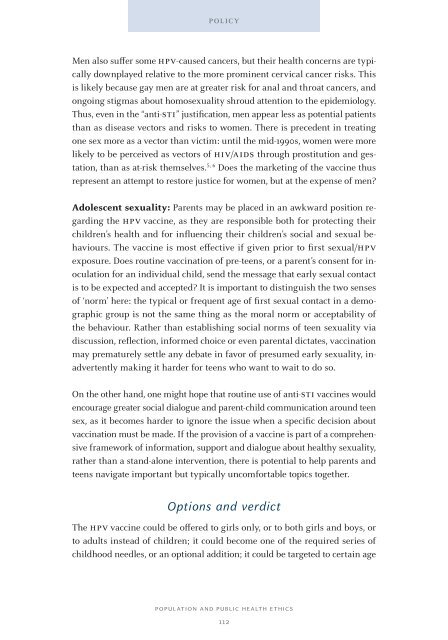PoPulationand Public HealtH etHics
PoPulationand Public HealtH etHics
PoPulationand Public HealtH etHics
Create successful ePaper yourself
Turn your PDF publications into a flip-book with our unique Google optimized e-Paper software.
policy<br />
Men also suffer some HPV-caused cancers, but their health concerns are typically<br />
downplayed relative to the more prominent cervical cancer risks. This<br />
is likely because gay men are at greater risk for anal and throat cancers, and<br />
ongoing stigmas about homosexuality shroud attention to the epidemiology.<br />
Thus, even in the “anti-stI” justification, men appear less as potential patients<br />
than as disease vectors and risks to women. There is precedent in treating<br />
one sex more as a vector than victim: until the mid-1990s, women were more<br />
likely to be perceived as vectors of HIV/aIDs through prostitution and gestation,<br />
than as at-risk themselves. 5, 6 Does the marketing of the vaccine thus<br />
represent an attempt to restore justice for women, but at the expense of men?<br />
Adolescent sexuality: Parents may be placed in an awkward position regarding<br />
the HPV vaccine, as they are responsible both for protecting their<br />
children’s health and for influencing their children’s social and sexual behaviours.<br />
The vaccine is most effective if given prior to first sexual/HPV<br />
exposure. Does routine vaccination of pre-teens, or a parent’s consent for inoculation<br />
for an individual child, send the message that early sexual contact<br />
is to be expected and accepted? It is important to distinguish the two senses<br />
of ‘norm’ here: the typical or frequent age of first sexual contact in a demographic<br />
group is not the same thing as the moral norm or acceptability of<br />
the behaviour. Rather than establishing social norms of teen sexuality via<br />
discussion, reflection, informed choice or even parental dictates, vaccination<br />
may prematurely settle any debate in favor of presumed early sexuality, inadvertently<br />
making it harder for teens who want to wait to do so.<br />
On the other hand, one might hope that routine use of anti-stI vaccines would<br />
encourage greater social dialogue and parent-child communication around teen<br />
sex, as it becomes harder to ignore the issue when a specific decision about<br />
vaccination must be made. If the provision of a vaccine is part of a comprehensive<br />
framework of information, support and dialogue about healthy sexuality,<br />
rather than a stand-alone intervention, there is potential to help parents and<br />
teens navigate important but typically uncomfortable topics together.<br />
Options and verdict<br />
The HPV vaccine could be offered to girls only, or to both girls and boys, or<br />
to adults instead of children; it could become one of the required series of<br />
childhood needles, or an optional addition; it could be targeted to certain age<br />
PoPulation anD <strong>Public</strong> <strong>HealtH</strong> <strong>etHics</strong><br />
112
















